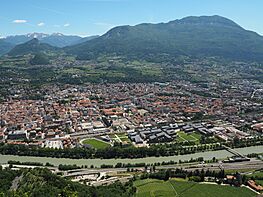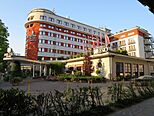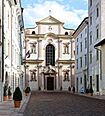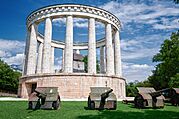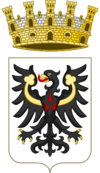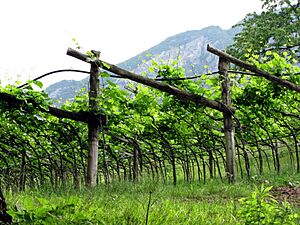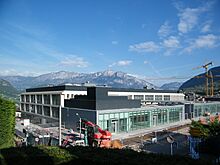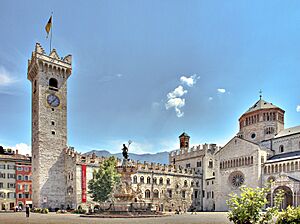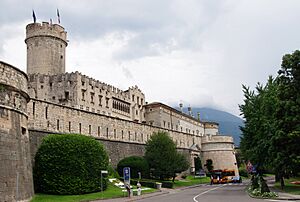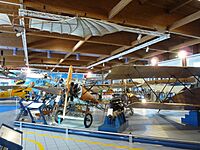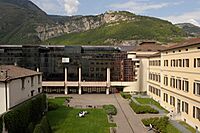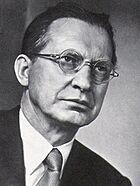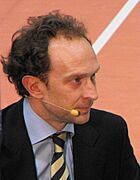Trento facts for kids
Quick facts for kids
Trento
Trent (Ladin)
|
|||
|---|---|---|---|
| Comune di Trento | |||
|
Clockwise from top: Aerial view of Trento, Fontana del Nettuno, Church of San Francesco Saverio, Torre Civica of Trento, Mausoleum of Cesare Battisti, Grand Hotel Trento, Piazza duomo with the Trento Cathedral in the background
|
|||
|
|||
| Country | Italy | ||
| Region | Trentino-Alto Adige/Südtirol | ||
| Province | Trentino (TN) | ||
| Frazioni | see list | ||
| Area | |||
| • Total | 157.9 km2 (61.0 sq mi) | ||
| Elevation | 194 m (636 ft) | ||
| Population
(2020)
|
|||
| • Total | 120,709 | ||
| • Density | 764.46/km2 (1,980.0/sq mi) | ||
| Demonym(s) | Trentini, Tridentini | ||
| Time zone | UTC+1 (CET) | ||
| • Summer (DST) | UTC+2 (CEST) | ||
| Postal code |
38121-38122-38123
|
||
| Dialing code | 0461 | ||
| Patron saint | Saint Vigilius | ||
| Saint day | June 26 | ||
Trento (also called Trent in English) is a beautiful city in Italy. It is located on the Adige River in the region of Trentino-Alto Adige/Südtirol. Trento is the capital of the autonomous province of Trento.
This city has a rich history. In the 1500s, an important meeting called the Council of Trent took place here. Trento was once part of Austria and Austria-Hungary. It became part of Italy in 1919. With over 118,000 people, Trento is one of the largest Italian cities in the Alps.
Trento is a key place for education, science, money, and politics in its region. The city center is very pretty, with old Medieval and Renaissance buildings. You can see amazing places like Trento Cathedral and the Castello del Buonconsiglio.
Trento is known for its high quality of life. It often ranks among the best Italian cities for living and finding jobs. It is also one of Italy's wealthiest cities. Its province is one of the richest in the country.
The University of Trento was started in 1962. It is a well-known university with a strong international focus. It is considered one of the best medium-sized universities in Italy. The university's School of International Studies is part of a special group of top schools worldwide.
Over the last 20 years, Trento has become a hub for research. New research centers and labs in IT, engineering, and science have opened. Because of this, Trento and its university are sometimes called the "Silicon Valley of the Alps."
Contents
Discovering Trento's Past
Trento is located on an old river route that leads to Bolzano and important mountain passes. These passes include the Brenner Pass and the Reschen Pass. The city's beginnings are debated by historians. Some think it was a settlement of the Rhaetian people. Others believe the Gauls (a Celtic group) founded the city around 400 BC.
Roman Times in Tridentum
The Romans took over Trento in the 1st century BC. Before the Romans, it was a Celtic village. Julius Caesar helped make it a Roman town. The Romans called it Tridentum. This name might mean "Three-teeth place" or "Trident-town." The reason for the name is not fully clear. It could be linked to the god Neptune. Or, it might be named after the three hills around the city. These hills are Doss Trento, Doss di Sant'Agata, and Doss di San Rocco.
An old Latin saying on the city hall says: "Mountains give me silver and the name of Trento." This shows the city's connection to its natural surroundings. Tridentum became an important stop on the Roman road from Verona to Innsbruck.
Medieval Era and Prince-Bishops
After the Western Roman Empire fell, Trento was ruled by different groups. These included the Ostrogoths, Byzantines, Lombards, and Franks. Eventually, it became part of the Holy Roman Empire. In 1027, Emperor Conrad II created the Prince-Bishops of Trento. These bishops had both religious and political power.
Over the next few centuries, power was shared. It was split between the Bishopric of Trent and the County of Tyrol. Around 1200, Trento became important for mining. Silver was found in Monte Calisio. Prince-Bishop Federico Wanga even created the first mining laws for the Alpine region.
A Difficult Time in History
In the 14th century, the Habsburg family became the counts of Tyrol. A sad event happened in Trento in 1475. A young Christian boy disappeared. The city's small Jewish community was wrongly accused of harming him. Several Jewish people were punished, and their families were forced to change their religion.
The bishop of Trento tried to make the boy a saint. He also published a book about the event. In the 1990s, Trento apologized to the Jewish community for this dark part of its history. A special plaque was put up to remember the apology.
The Council of Trent and Beyond
In the 1500s, Trento became famous for the Council of Trent (1545–1563). This important meeting led to the Counter-Reformation in the Catholic Church. The word Tridentine (as in "Tridentine Mass") means "related to Trento." It also refers to this specific historical event.
Important prince-bishops like Bernardo Clesio and Cristoforo Madruzzo governed Trento during this time. They were skilled politicians and humanists. They helped the city grow and become more beautiful. During this period, Trento was also a place where Jewish books were printed.
Changing Rulers and World Wars
Prince-bishops ruled Trento until the time of Napoleon. Then, the city changed hands many times. In 1802, it became part of the Habsburg lands. In 1805, it was given to Bavaria. Four years later, Napoleon's Kingdom of Italy took control.
The people of Trento fought against French rule. Andreas Hofer was a leader of this resistance. He was welcomed in Trento when he helped the Austrians take it back in 1809. Many volunteers from Trento died fighting the French and Bavarian troops. Hofer was later captured and executed.
In 1814, after Napoleon's defeat, Trento became part of the Habsburg Empire again. The church no longer governed the city. Trento was then ruled by the secular administration of Tyrol. The city modernized, and the first railroad in the Adige valley opened in 1859.
In the late 1800s, Trento and Trieste were cities with many Italian speakers. They still belonged to Austria. This led to the Italian irredentist movement, which wanted these lands to join Italy. Benito Mussolini even worked for a local newspaper in Trento for a short time.
The desire for these lands led Italy into World War I. Local figures like Cesare Battisti joined the Italian Army to fight Austria-Hungary. They wanted Trento to become part of Italy. Both men were captured and executed in the courtyard of Castello del Buonconsiglio.
The region was heavily affected by the war. Many battles were fought in the surrounding mountains. After World War I, Trento and its Italian-speaking province became part of Italy. This also included Bolzano and the southern part of Tyrol.
In July 1943, during World War II, Mussolini was removed from power. Italy surrendered to the Allies. German troops then invaded northern Italy. Trento became part of a German-controlled area. From November 1944 to April 1945, Trento was bombed. This was part of the "Battle of the Brenner." War supplies from Germany passed through the Brenner Pass. Many parts of the city were hit, but most of the old city center was saved. Trento was finally freed on May 3, 1945.
Since the 1950s, the region has grown a lot. This is partly because it has special self-governing powers from the Italian government. In 2015, the cathedral tower caught fire. In 2020, Trento was named the most sustainable city in Italy.
Exploring Trento's Geography
The city of Trento includes the main city center and many smaller areas. These areas range from industrial suburbs to tiny mountain villages. Many of these smaller places still feel like traditional rural or mountain communities.
Trento is located in a wide valley formed by glaciers. This is the Adige valley, just south of the Dolomite Mountains. The Fersina River and Avisio rivers join the Adige River here. The Adige is Italy's second-longest river. Its path near Trento was straightened in 1850.
The valley is surrounded by mountains. These include Vigolana (2,150 meters), Monte Bondone (2,181 meters), Paganella (2,124 meters), Marzola (1,747 meters), and Monte Calisio (1,096 meters). Nearby lakes include Lake Caldonazzo, Lake Levico, Lake Garda, and Lake Toblino.
Frazioni (Subdivisions)
Trento has several smaller areas called frazioni:
- Povo
- Villazzano
- Gardolo
- Roncafort
- Mattarello
- Martignano
- Cognola
- Ravina
- Romagnano
- Montevaccino
- Vela
- Meano
- Sardagna
- Sopramonte
- Vigo Meano
- Cortesano
- Gazzadina
- Candriai
- Vaneze
- Cadine
- Vigolo Baselga
Trento's Climate and Weather
Trento is located at different heights above sea level. The city center is around 200 meters high. Some areas like Povo and Cognola are at 400 meters. Monte Bondone is much higher, at 2000 meters. Higher areas have a colder, alpine climate.
The main city of Trento has a humid subtropical-continental climate. This means it has warm, humid summers and cold winters. Average monthly temperatures range from 1.6°C in January to 23.4°C in July.
Trento gets over 900 mm of rain each year. The rainiest times are late spring (May–June) and autumn (October–November). Winters are cold, with frost from mid-November to mid-March. Snowfall is not very common in the city center.
Summers are hot, sometimes very hot. Temperatures can reach 35°C for about a week each year. Nights can also be warm. Fall is pleasant, with leaves changing color. The first snow in the higher suburbs can happen in late November. December and early January are usually the snowiest months.
| Climate data for Trento Laste, elevation: 312 m (1981–2010, extremes 1958–2010) | |||||||||||||
|---|---|---|---|---|---|---|---|---|---|---|---|---|---|
| Month | Jan | Feb | Mar | Apr | May | Jun | Jul | Aug | Sep | Oct | Nov | Dec | Year |
| Record high °C (°F) | 19.2 (66.6) |
23.6 (74.5) |
29.0 (84.2) |
31.0 (87.8) |
37.4 (99.3) |
38.9 (102.0) |
39.5 (103.1) |
41.4 (106.5) |
33.5 (92.3) |
28.3 (82.9) |
22.8 (73.0) |
16.6 (61.9) |
41.4 (106.5) |
| Mean daily maximum °C (°F) | 5.2 (41.4) |
9.2 (48.6) |
15.2 (59.4) |
18.5 (65.3) |
23.1 (73.6) |
26.8 (80.2) |
29.4 (84.9) |
28.3 (82.9) |
22.8 (73.0) |
16.4 (61.5) |
9.5 (49.1) |
4.9 (40.8) |
17.4 (63.3) |
| Daily mean °C (°F) | 1.6 (34.9) |
4.3 (39.7) |
9.5 (49.1) |
13.0 (55.4) |
17.6 (63.7) |
21.1 (70.0) |
23.4 (74.1) |
22.5 (72.5) |
17.8 (64.0) |
12.4 (54.3) |
5.9 (42.6) |
1.7 (35.1) |
12.6 (54.7) |
| Mean daily minimum °C (°F) | −2.1 (28.2) |
−0.6 (30.9) |
3.9 (39.0) |
7.6 (45.7) |
12.2 (54.0) |
15.4 (59.7) |
17.4 (63.3) |
16.7 (62.1) |
12.8 (55.0) |
8.3 (46.9) |
2.4 (36.3) |
−1.5 (29.3) |
7.7 (45.9) |
| Record low °C (°F) | −15.2 (4.6) |
−11.3 (11.7) |
−10.1 (13.8) |
−2.7 (27.1) |
1.5 (34.7) |
6.3 (43.3) |
9.5 (49.1) |
7.2 (45.0) |
3.3 (37.9) |
−3.7 (25.3) |
−6.6 (20.1) |
−12.3 (9.9) |
−15.2 (4.6) |
| Average precipitation mm (inches) | 42.1 (1.66) |
33.9 (1.33) |
54.0 (2.13) |
78.1 (3.07) |
94.4 (3.72) |
92.4 (3.64) |
86.7 (3.41) |
83.8 (3.30) |
82.3 (3.24) |
116.8 (4.60) |
106.2 (4.18) |
65.8 (2.59) |
936.6 (36.87) |
| Average snowfall cm (inches) | 19.2 (7.6) |
9.8 (3.9) |
3.1 (1.2) |
0.3 (0.1) |
0.0 (0.0) |
0.0 (0.0) |
0.0 (0.0) |
0.0 (0.0) |
0.0 (0.0) |
0.1 (0.0) |
2.8 (1.1) |
14.3 (5.6) |
49.6 (19.5) |
| Average precipitation days | 4.0 | 3.4 | 5.7 | 8.2 | 9.5 | 9.5 | 8.2 | 8.1 | 7.0 | 7.6 | 7.1 | 5.5 | 83.7 |
| Average relative humidity (%) | 69 | 66 | 66 | 69 | 72 | 71 | 71 | 72 | 73 | 77 | 75 | 59 | 70 |
| Source 1: Agenzia Provinciale per la Protezione dell'Ambiente | |||||||||||||
| Source 2: Meteotrentino | |||||||||||||
People and Population
| Historical population | ||
|---|---|---|
| Year | Pop. | ±% |
| 1921 | 51,174 | — |
| 1931 | 55,054 | +7.6% |
| 1936 | 56,656 | +2.9% |
| 1951 | 62,887 | +11.0% |
| 1961 | 75,753 | +20.5% |
| 1971 | 91,768 | +21.1% |
| 1981 | 99,179 | +8.1% |
| 1991 | 101,545 | +2.4% |
| 2001 | 104,946 | +3.3% |
| 2011 | 114,198 | +8.8% |
| 2021 | 117,847 | +3.2% |
| Source: ISTAT | ||
As of December 2023, Trento had about 119,180 residents. About 48% were male and 52% were female. Children (14 and younger) made up 12.6% of the population. Older people (65 and above) were 24.4%. The average age in Trento is 45.5 years. This is a bit younger than the Italian average of 46.8.
Between 2018 and 2023, Trento's population grew by 0.72%. Italy's population as a whole decreased during this time. Trento's birth rate is 9.61 births per 1,000 people. This is slightly higher than the Italian average.
Most of Trento's population (92.68%) is Italian. The largest groups of immigrants come from other European countries. These include Albania and Romania. Smaller groups come from North Africa and the Americas.
Trento's Economy and Business
Trento's unique economy comes from its location. It is on a main route between Italy and Northern Europe. The Adige River also played a big role. Before it was moved in the mid-1800s, the river ran through the city center. The Adige River used to be a major trade route in the Alps.
Before World War II, Trento relied on making wine and silk. Today, sparkling wine from the Trentino province is famous. It is part of the Trento DOC classification. Most of the old manufacturing industries have been removed.
Now, Trento's economy is based on trade, services, and tourism. It also has high-quality agriculture and food industries, like wine and fruit. The city is a center for research and conferences. This is thanks to its well-known university and international research centers. These centers include Fondazione Bruno Kessler and the Italian-German Historical Institute.
Beautiful pink and white stone called porphyry is still dug up from nearby areas. You can see this stone in many of Trento's buildings, both old and new.
The city hosts two annual sports events. The Giro al Sas is a 10 km professional running race. It started in 1907. The Giro del Trentino is a yearly road cycling race. Trento has hosted it since 1963.
Economy Festival of Trento
The Festival dell’Economia di Trento (Economy Festival of Trento) began in 2006. Its goal is to help economists and the public talk about economic ideas. The festival aims to make economic terms easy for everyone to understand.
It happens every year in late May. Events take place in the historic buildings of Trento's old town. Famous economists explain current economic issues. They look at them from scientific, social, and business points of view. Many well-known experts have taken part in the festival.
Main Sights and Landmarks
Trento has many interesting historical buildings. Its architecture is unique, mixing Italian Renaissance and Roman styles. The city center is small. Most of the old Medieval and Renaissance buildings have been restored. They now show their original pastel colors and wooden balconies.
Part of the old city walls can still be seen in Piazza Fiera. There is also a round tower there. These walls once surrounded the whole city. They were connected to the Castello del Buonconsiglio.
Here are some of the main sights in Trento:
- Cattedrale di San Vigilio (Cathedral of Saint Vigilius): This Romanesque-Gothic cathedral was built in the 12th–13th century. It stands on top of an older Roman church. You can see the remains of the Roman church in an underground crypt.
- Piazza Duomo (1767–1768): This square is next to the cathedral. It has Renaissance buildings with beautiful paintings on their walls. You can also see the Fountain of Neptune (Fontana di Nettuno) here.
- Church of Santa Maria Maggiore (1520): This church was where important meetings of the Council of Trent took place. It was built in a Renaissance-Gothic style. The church has a notable entrance from the 16th century. Inside, you can see artworks by famous painters.
- Castello del Buonconsiglio (Buonconsiglio Castle) (13th century): This castle now has a museum. It also has the famous Torre dell'Aquila (Eagle Tower). This tower has amazing Gothic paintings showing the months of the year.
- Church of San Pietro (12th century): This church has a new Gothic front added in the mid-1800s.
- Church of Sant'Apollinare (13th century): This is a Gothic-style church.
- Church of San Lorenzo (12th century): This church has a Romanesque apse (a rounded part at the end).
- Torre Verde (Green Tower): This tower is along the old path of the Adige river. It is said that people who were executed were put into the river from here.
- Palazzo delle Albere (Palace of the Trees): This Renaissance villa is next to the Adige river. It was built around 1550 by the Madruzzo family. Now, it is home to a modern art museum.
- Palazzo Pretorio (12th century): This palace is next to the Duomo. It has a bell tower (Torre Civica) from the 13th century. It now holds a collection of religious paintings. This was the main home for the Bishops until the mid-1200s.
- Palazzo Salvadori (1515): This is one of the first examples of Renaissance buildings for citizens in Trento.
- Palazzo Geremia (15th century): This building has a Renaissance outside and Gothic rooms inside.
- Palazzo Lodron: This palace was built during the Council of Trent. Its inside has many fresco paintings.
- You can also see underground remains of Roman streets and villas. These are found in Via Prepositura and Piazza Cesare Battisti.
Trento also has modern buildings. These include the train station and the central post office. Both were designed by the architect Angiolo Mazzoni. The train station (1934–36) is considered an important building for Italian railways. It uses local stone and modern materials like glass and concrete. The post office used to have colorful windows by Fortunato Depero, but they were destroyed in World War II bombings.
Gallery
-
MUSE, the science museum designed by Renzo Piano
-
Monument to Dante Alighieri in Piazza Dante
Culture and Museums
Museums to Explore
- MUSE - Museo delle Scienze: This is a science and natural history museum. It was designed by Renzo Piano and opened in 2013.
- Municipal Gallery: This gallery is part of the Museum of Modern and Contemporary Art of Trento and Rovereto (MART).
- Regional Museum of Art: Located in the Castello del Buonconsiglio, this museum was once the home of the Prince-Bishops of Trento.
- The Tridentine Diocesan Museum: This museum is in the Palazzo Pretorio, next to the Cathedral Square. It displays art from the diocese of Trento and shows how the Council of Trent influenced the city.
- Viote Alpine Botanical Garden: This garden is on Monte Bondone. It was founded in 1938. The areas around Trento are known for their mountain views. They are popular for both summer and winter tourism.
- Museo dell'Aeronautica Gianni Caproni: This is an aviation museum. It is located in Mattarello, near Trento's airport.
Theatres for Performances
- Teatro Sociale: Built in 1819.
- Teatro Auditorium
- Teatro San Marco
- Teatro di Meano: Located in the area of Meano.
Fun Events in Trento
- Economy Festival Trento
- Mountain Film Festival
- Christmas Market of Trento
- A Tutto Nosiola – A food and wine event
- Gemme di Gusto – Another food and wine event
- DiVin Ottobre – A fall food and wine event
Education and Learning
The University of Trento was started in 1962. Its main campus is in Trento. Another university location is in Rovereto. More than 16,000 students study in Trento. The university also works closely with the universities of Innsbruck and Bolzano. This is part of the Euroregion Tyrol-South Tyrol-Trentino.
Getting Around Trento
The Autostrada A22 highway connects Trento to Verona. It also links to Bolzano, Innsbruck, and Munich. This highway is part of the European route E45.
Trento railway station opened in 1859. It is part of the Brenner railway. This is the main train line between Italy and Germany. The station is also a connection point for the Valsugana railway. This line connects Trento to Venice. Trento has other train stations too. One is Trento FTM railway station, which is the end of the Trento-Malè-Marilleva railway.
Buses and trains go to the main valleys around Trento. These include Fassa, Fiemme, Non, and Valsugana.
The city's public transport system has 20 bus lines. These are run by Trentino Trasporti. There is also a cable car service to Sardagna. All the train stations within Trento are part of this public transport network.
Sports in Trento
Local Sports Teams
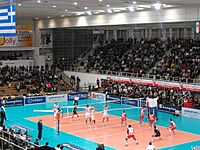
- Trentino Volley: This is one of the best teams in Italian volleyball. They have won the Italian championship four times. They have also won the CEV Champions League three times and the club world cup five times.
- Aquila Basket Trento: This basketball team has played in Italy's top league for several years. They reached the play-off finals in the 2016/17 and 2017/18 seasons.
- A.C. Trento S.C.S.D.: This is one of the oldest football clubs in the Trentino Alto Adige region. It was founded in 1921. Since 2021, the club has been playing in the third-highest Italian league, the Serie C.
Sports Venues
PalaTrento, now called BLM Group Arena, opened in 2000. It is an indoor arena with seats for 4,300 people. Trentino Volley and Aquila Basket Trento play their games here.
- Stadio Briamasco: This is a football stadium with 4,277 seats. It is currently the home stadium for AC Trento.
Famous People from Trento
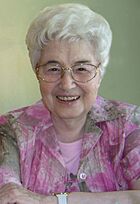
Many notable people were born in or have connections to Trento:
- Jacopo Aconcio (around 1520–1566): An Italian lawyer, religious scholar, philosopher, and engineer.
- Beniamino Andreatta (1928–2007): An Italian economist and politician.
- Cesare Battisti (1875–1916): An Italian patriot during the movement to unite Italy.
- Francesco Antonio Bonporti (1672–1749): An Italian priest and composer.
- Alcide De Gasperi (1881–1954): The 30th Prime Minister of Italy. He was one of the people who helped create the European Union.
- Chiara Lubich (1920–2008): An Italian teacher and writer. She founded the Focolare Movement.
- Martino Martini (1614–1661): A Jesuit missionary, geographer, and historian.
- Paolo Oss Mazzurana (1833–1895): Trento's most famous mayor. His policies helped Trento's businesses and its independence.
- Francesca Neri (born 1964): An Italian actress.
- Andrea Pozzo (1642–1709): A Jesuit Brother, baroque painter, and architect.
Sports Figures
- Lorenzo Bernardi (born 1968): An Italian volleyball coach and former player. He won a silver medal at the 1996 Summer Olympics.
- Attilio Bettega (1953–1985): A rally car driver.
- Mirko Bortolotti (born 1990): A racing car driver.
- Thomas Degasperi (born 1981): A water skier and two-time World Champion.
- Cesare Maestri (1929–2021): An Italian mountaineer and writer.
- Amos Mosaner (born 1995): An Italian curler. He won a gold medal at the 2022 Winter Olympics.
- Marvin Vettori (born 1993): An Italian professional mixed martial artist.
International Connections
Twin Towns – Sister Cities
Trento is connected with these cities:
 Charlottenburg-Wilmersdorf (Berlin), Germany (1966)
Charlottenburg-Wilmersdorf (Berlin), Germany (1966) San Sebastián, Spain (1987)
San Sebastián, Spain (1987) Kempten, Germany (1987)
Kempten, Germany (1987) Prague 1, Czech Republic (2002)
Prague 1, Czech Republic (2002)
Some districts of Trento are also twinned with:
 Schwaz, Austria
Schwaz, Austria Fließ, Austria
Fließ, Austria Ergolding, Germany
Ergolding, Germany Herrsching, Germany
Herrsching, Germany Neufahrn bei Freising, Germany
Neufahrn bei Freising, Germany Znojmo, Czech Republic
Znojmo, Czech Republic
Partner Cities
Images for kids
See also
 In Spanish: Trento para niños
In Spanish: Trento para niños


